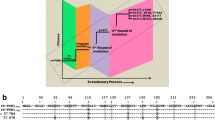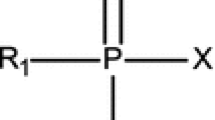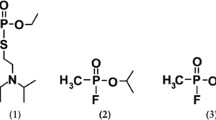Abstract
Organophosphate (OP) compounds are neurotoxic chemicals, and current treatments available for OP-poisoning are considered as unsatisfactory and inadequate. There is an urgent need for the development of more effective treatment(s) for OP-poisoning. Human paraoxonase 1 (h-PON1) is known to hydrolyze a variety of OP-compounds and is a leading candidate for the development of prophylactic and therapeutic agent against OP-poisoning in humans. Non-availability of effective system(s) for the production of recombinant h-PON1 (rh-PON1) makes it hard to produce improved variant(s) of this enzyme and analyze their in vivo efficacy in animal models. Production of recombinant h-PON1 (rh-PON1) using an Escherichia coli expression system is a key to develop variant(s) of h-PON1. Recently, we have developed a procedure to produce active rh-PON1 enzymes by using E. coli expression system. In this study, we have characterized the OP-hydrolyzing properties of refolded rh-PON1(wt) and rh-PON1(H115W;R192K) variant. Our results show that refolded rh-PON1(H115W;R192K) variant exhibit enhanced OP-hydrolyzing activity in in vitro and ex vivo assays and exhibited prophylactic activity in mouse model of OP-poisoning, suggesting that refolded rh-PON1 can be developed as a therapeutic candidate.





Similar content being viewed by others
Abbreviations
- AChE:
-
Acetylcholinesterase
- ATCh:
-
Acetylthiocholine
- CPO:
-
Chlorpyrifosoxon
- Chi-PON1:
-
Chimeric-paraoxonase 1
- CWNA:
-
Chemical warfare nerve agent
- DFP:
-
Diisopropylflourophosphate
- DTNB:
-
Dithionitrobenzoic acid
- h-PON1:
-
Human paraoxonase 1
- rh-PON1:
-
Recombinant human paraoxonase 1
- OP:
-
Organophosphate
References
King, A. M., & Aaron, C. K. (2015). Organophosphate and carbamate poisoning. Emergency Medicine Clinics of North America, 1, 133–151.
Bajgar, J. (2004). Organophosphates/nerve agent poisoning: mechanism of action, diagnosis, prophylaxis, and treatment. Advances in Clinical Chemistry, 38, 151–216.
Balali-Mood, M., & Saber, H. (2012). Recent advances in the treatment of organophosphorous poisonings. Iran Journal of Medical Sciences, 2, 74–91.
Bloch-Shilderman, E., Rabinovitz, I., Egoz, I., Raveh, L., Allon, N., Grauer, E., Gilat, E., & Weissman, B. A. (2008). Subchronic exposure to low-doses of the nerve agent VX: physiological, behavioral, histopathological and neurochemical studies. Toxicology and Applied Pharmacology, 1, 17–23.
Jokanovic, M., & Kosanovic, M. (2010). Neurotoxic effects in patients poisoned with organophosphorus pesticides. Environmental Toxicology and Pharmacology, 3, 195–201.
Marrs, T. C., & Maynard, R. L. (2013). Neurotransmission systems as targets for toxicants. Cell Biology and Toxicology, 6, 381–396.
Bomser, J. A., & Casida, J. E. (2001). Diethylphosphorylation of rat cardiac M2 muscarinic receptor by chlorpyrifosoxon in vitro. Toxicology Letters, 1, 21–26.
Iyer, R., Iken, B., & Leon, A. (2015). Developments in alternative treatments for organophosphate poisoning. Toxicology Letters, 2, 200–206.
Masson, P., & Rochu, D. (2009). Catalytic bioscavengers against toxic esters, an alternative approach for prophylaxis and treatments of poisonings. Acta Naturae, 1, 68–79.
Nachon, F., Brazzolotto, X., Trovaslet, M., & Masson, P. (2013). Progress in the development of enzyme-based nerve agent bioscavengers. Chemico-Biological Interactions, 3, 536–544.
Ahmed, Z., Ravandi, A., Maguire, G. F., Emili, A., Draganov, D., La Du, B. N., Kuksis, A., & Connelly, P. W. (2002). Multiple substrates for paraoxonase-1 during oxidation of phosphatidylcholine by peroxynitrite. Biochemical and Biophysical Research Communications, 1, 391–396.
Rosenblat, M., Gaidukov, L., Khersonsky, O., Vaya, J., Oren, R., & Tawfik, D. S. (2006). The catalytic histidine dyad of high density lipoprotein-associated serum paraoxonase-1 (PON1) is essential for PON1-mediated inhibition of low density lipoprotein oxidation and stimulation of macrophage cholesterol efflux. Journal of Biological Chemistry, 11, 7657–7665.
Kar, S., Patel, M. A., Tripathy, R. K., Bajaj, P., & Pande, A. H. (2013). Oxidized-phospholipids in reconstituted high density lipoprotein particles affect structure and function of recombinant paraoxonase 1. Biochimica et Biophysica Acta, 12, 1714–1720.
Gaidukov, L., Bar, D., Yacobson, S., Naftali, E., Kaufman, O., & Tabakman, R. (2009). In vivo administration of BL-3050: highly stable engineered PON1-HDL complexes. BMC Clinical Pharmacology, 9, 18–26.
Li, W. F., Furlong, C. E., & Costa, L. G. (1995). Paraoxonase protects against chlorpyrifos toxicity in mice. Toxicology Letters, 3, 219–226.
Valiyaveettil, M., Alamneh, Y., Rezk, P., Perkins, M. W., Sciuto, A. M., & Doctor, B. P. (2011). Recombinant paraoxonase 1 protects against sarin and soman toxicity following microinstillation inhalation exposure in guinea pigs. Toxicology Letters, 3, 203–208.
Stevens, R. C., Suzuki, S. M., Cole, T. B., Park, S. S., Richter, R. J., & Furlong, C. E. (2008). Engineered recombinant human paraoxonase 1 (rHuPON1) purified from Escherichia coli protects against organophosphate poisoning. Proceedings of the National Academy of Sciences of the United States of America, 35, 12780–12784.
Worek, F., Seeger, T., Goldsmith, M., Ashani, Y., Leader, H., Sussman, J. L., Tawfik, D., Thiermann, H., & Wille, T. (2014). Efficacy of the rePON1 mutant IIG1 to prevent cyclosarin toxicity in vivo and to detoxify structurally different nerve agents in vitro. Archives of Toxicology, 6, 1257–1266.
Lenz, D. E., Yeung, D., Smith, J. R., Sweeney, R. E., Lumley, L. A., & Cerasoli, D. M. (2007). Stoichiometric and catalytic scavengers as protection against nerve agent toxicity: a mini review. Toxicology, 1–3, 31–39.
Rochu, D., Chabriere, E., & Masson, P. (2007). Human paraoxonase: a promising approach for pre-treatment and therapy of organophosphorus poisoning. Toxicology, 1–3, 47–59.
Bajaj, P., Tripathy, R. K., Aggarwal, G., and Pande, A. H. (2014). Human paraoxonase 1 as a pharmacologic agent: limitations and perspectives. ScientificWorld Journal. 2014, 354-391.
Brushia, R. J., Forte, T. M., Oda, M. N., La Du, B. N., & Bielicki, J. K. (2006). Baculovirus-mediated expression and purification of human serum paraoxonase 1. Journal of Lipid Research, 6, 951–958.
Bajaj, P., Tripathy, R. K., Aggarwal, G., & Pande, A. H. (2013). Characterization of human paraoxonase 1 variants suggest that His residues at 115 and 134 positions are not always needed for the lactonase/arylesterase activities of the enzyme. Protein Sciences, 12, 1799–1807.
Aharoni, A., Gaidukov, L., Yagur, S., Toker, L., Silman, I., & Tawfik, D. S. (2004). Directed evolution of mammalian paraoxonases PON1 and PON3 for bacterial expression and catalytic specialization. Proceedings of the National Academy of Sciences of the United States of America, 2, 482–487.
Bajaj, P., Aggarwal, G., Tripathy, R. K., and Pande, A. H. (2014). Interplay between amino acid residues at positions 192 and 115 in modulating hydrolytic activities of human paraoxonase 1. Biochimie, 105, 202-210.
Bajaj, P., Tripathy, R. K., Aggarwal, G., & Pande, A. H. (2015). Expression and purification of biologically active recombinant human paraoxonase 1 from inclusion bodies of Escherichia coli. Protein Expression and Purification, 115, 95–101.
Amitai, G., Gaidukov, L., Adani, R., Yishay, S., Yacov, G., & Kushnir, M. (2006). Enhanced stereoselective hydrolysis of toxic organophosphates by directly evolved variants of mammalian serum paraoxonase. FEBS Journal, 9, 1906–1919.
Ashani, Y., Goldsmith, M., Leader, H., Silman, I., Sussman, J. L., & Tawfik, D. S. (2011). In vitro detoxification of cyclosarin in human blood pre-incubated ex vivo with recombinant serum paraoxonases. Toxicology Letters, 1, 24–28.
Costa, L. G., McDonald, B. E., Murphy, S. D., Omenn, G. S., Richter, R. J., & Motulsky, A. G. (1990). Serum paraoxonase and its influence on paraoxon and chlorpyrifos-oxon toxicity in rats. Toxicology and Applied Pharmacology, 1, 66–76.
Aggarwal, G., Prajapati, R., Tripathy, R. K., Bajaj, P., Iyengar, A. R. S., Sangamwar, A. T., & Pande, A. H. (2016). Toward understanding the catalytic mechanism of human paraoxonase 1: site-specific mutagenesis at position 192. PloS One, 11, e0147999.
Ashani, Y., & Pistinner, S. (2004). Estimation of the upper limit of human butyrylcholinesterase dose required for protection against organophosphates toxicity: a mathematically based toxicokinetic model. Toxicological Sciences, 2, 358–367.
James, R. W., & Deakin, S. P. (2010). The contribution of high density lipoprotein apolipoproteins and derivatives to serum paraoxonase-1 activity and function. Advances in Experimental Medicine & Biology, 660, 173–181.
La Du, B. N., Aviram, M., Billecke, S., Navab, M., Primo-Parmo, S., Sorenson, R. C., & Standiford, T. J. (1999). On the physiological role(s) of the paraoxonases. Chemico-Biological Interactions, 119–120, 379–388.
Kar, S., Patel, M. A., Tripathy, R. K., Bajaj, P., Suvarnakar, U. V., & Pande, A. H. (2012). Oxidized phospholipid content destabilizes the structure of reconstituted high density lipoprotein particles and changes their function. Biochimica et Biophysica Acta, 9, 1200–1210.
Acknowledgments
This work was supported by the research grant to AHP from NIPER, S.A.S. Nagar (NPLC-AHP). The authors are grateful to Prof. Dan S. Tawfik (Weizmann Institute of Science, Rehovot, Israel) for kindly providing us with the plasmid containing Chi-PON1 and to Prof. Richard W. James (University Hospital, Geneva, Switzerland) for the gift of monoclonal mouse anti-HuPON1 antibody.
Author information
Authors and Affiliations
Corresponding author
Ethics declarations
The experimental protocol was duly approved by Institutional Ethics Committee, NIPER S.A.S. Nagar (IAEC/12/71), and care for animals was carried out according to the guidelines by Committee for the Purpose of Control and Supervision of Experiments on Animals, Government of India.
Conflict of Interest
The authors declare that they have no conflict of interest.
Rights and permissions
About this article
Cite this article
Bajaj, P., Tripathy, R.K., Aggarwal, G. et al. Refolded Recombinant Human Paraoxonase 1 Variant Exhibits Prophylactic Activity Against Organophosphate Poisoning. Appl Biochem Biotechnol 180, 165–176 (2016). https://doi.org/10.1007/s12010-016-2091-y
Received:
Accepted:
Published:
Issue Date:
DOI: https://doi.org/10.1007/s12010-016-2091-y




